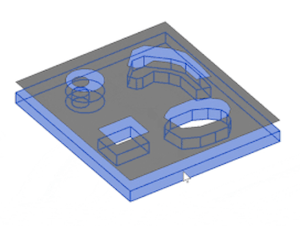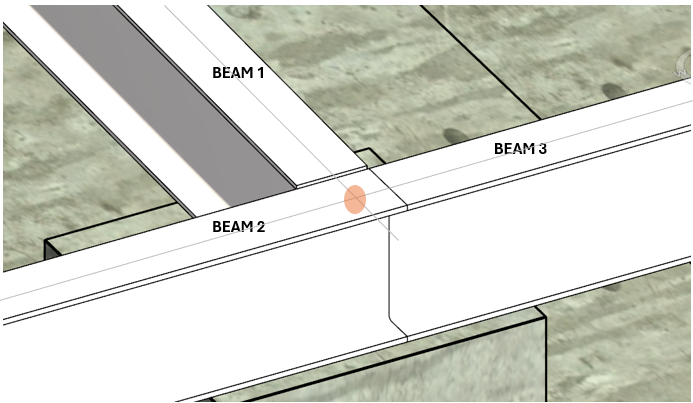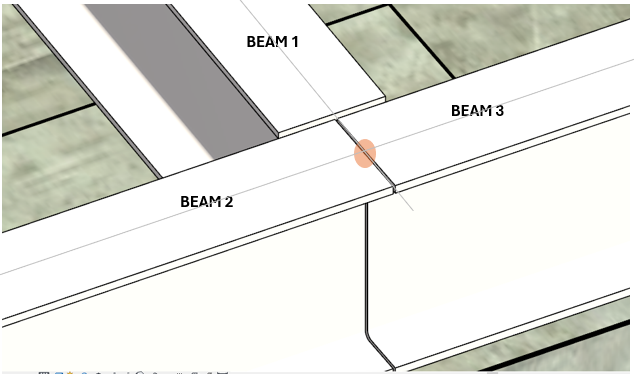Join Beams and Solid from Face
Let's look at creating an open shell, a solid extrusion from a face and defining a precise join between structural beams:
DirectShape Solid from Planar Face
Luiz Henrique @ricaun Cassettari explains how to create a DirectShape with only an open shell, with zero volume. He also shared a nice sample demonstrating how to create a solid from a PlanarFace using BRepBuilder based on slab sketch:
Question:
I need to create a Solid with a single PlanarFace using BRepBuilder.
The PlanarFace edges are based on a curves from sketch of a slab.
Answer: To start with, you can Look at the BRepBuilderExample Revit SDK sample. It includes a creation of a non-planar face, with no solid. The BRepBuilder class API documentation demonstrates in detail the creation of faces, edges, coedges, including arcs. Additional background information is provided by The Building Coder discussing BRepBuilder organisation.
BRepBuilder can still be tricky to work with.
In your case, to create an open shell, you need to set the target BRepType in the constructor to BRepType.OpenShell to allow the builder to return a solid without a volume.
Then, the code you share should work.
Sometimes, the orientation matters; especially in BRepType.Solid and BRepType.Void, you need to make sure all edges is registered in the correct orientation.
Finally, here is a full sample to create a solid from a planar face:

Click for animation
using Autodesk.Revit.Attributes;
using Autodesk.Revit.DB;
using Autodesk.Revit.UI;
using System;
namespace RevitAddin.Forum.Revit.Commands
{
[Transaction(TransactionMode.Manual)]
public class CommandFaceToSolid : IExternalCommand
{
public Result Execute(
ExternalCommandData commandData,
ref string message,
ElementSet elementSet)
{
UIApplication uiapp = commandData.Application;
Document document = uiapp.ActiveUIDocument.Document;
try
{
var faceReference = uiapp.ActiveUIDocument.Selection.PickObject(
Autodesk.Revit.UI.Selection.ObjectType.Face);
var element = document.GetElement(faceReference);
var face = element.GetGeometryObjectFromReference(faceReference)
as Face;
var solid = CreateSolidFromFace(face);
var normal = face.ComputeNormal(new UV(0.5, 0.5));
using (Transaction transaction = new Transaction(document))
{
transaction.Start("Create Solid");
var ds = DirectShape.CreateElement(document,
new ElementId(BuiltInCategory.OST_GenericModel));
ds.SetName(ds.Category.Name);
ds.SetShape(new[] { solid });
ds.Location.Move(normal);
transaction.Commit();
}
}
catch (Exception ex)
{
Console.WriteLine(ex);
}
return Result.Succeeded;
}
private Solid CreateSolidFromFace(Face face)
{
var surface = face.GetSurface();
var brepBuilder = new BRepBuilder(BRepType.OpenShell);
var faceIsReversed = !face.OrientationMatchesSurfaceOrientation;
BRepBuilderGeometryId faceId = brepBuilder.AddFace(
BRepBuilderSurfaceGeometry.Create(surface, null), faceIsReversed);
foreach (CurveLoop curveLoop in face.GetEdgesAsCurveLoops())
{
BRepBuilderGeometryId loopId = brepBuilder.AddLoop(faceId);
foreach (Curve curve in curveLoop)
{
var edge = BRepBuilderEdgeGeometry.Create(curve);
BRepBuilderGeometryId edgeId = brepBuilder.AddEdge(edge);
brepBuilder.AddCoEdge(loopId, edgeId, false);
}
brepBuilder.FinishLoop(loopId);
}
brepBuilder.SetFaceMaterialId(faceId, face.MaterialElementId);
brepBuilder.FinishFace(faceId);
brepBuilder.Finish();
return brepBuilder.GetResult();
}
}
}Many thanks to Ricaun for the nice sample and explanation.
Join Between Three Beams
Dayanand Rakte raised and solved another issue, to apply a join between 3 beams:
Question: I am struggling with join/connection between 3 beams. The current result looks like this:

The point highlighted with orange color is the endpoint location of Beam2 and Beam1, and the same point is start point location for Beam3. I want to connect these beams to achieve the following expected outcome:

It will be ok if there is no join between these three beams, but they should be place as expected. I tried the following approaches:
- First: I have not used JoinGeometry API and directly placed beams as per their location. In this approach I am getting random results, any of the the beam is extending which I don't have control.
- Second: I used the join geometry API as shown below. It generates the situation in the first image.
private void JoinGeometryBeam1ToBeam2Beam3(
Document activeDoc,
FamilyInstance Beam1)
{
XYZ minPt = primaryBeam.get_BoundingBox(activeDoc.ActiveView).Min;
XYZ maxPt = primaryBeam.get_BoundingBox(activeDoc.ActiveView).Max;
Outline outLine = new Outline(minPt, maxPt);
outLine.Scale(1.5);
BoundingBoxIntersectsFilter filter = new BoundingBoxIntersectsFilter(outLine);
List<FamilyInstance> connectedBeams
= new FilteredElementCollector(activeDoc)
.WherePasses(filter)
.OfCategory(BuiltInCategory.OST_StructuralFraming)
.OfClass(typeof(FamilyInstance))
.Cast<FamilyInstance>()
.ToList();
foreach (FamilyInstance beam in connectedBeams)
{
JoinGeometryUtils.JoinGeometry(this.ActiveDoc, beam, Beam1);
}
}How can the desired result be achieved?
Solution: It is working for me now. I disallowed join for Beam2 and Beam3 and Beam1 kept as it is. To disallow the join, I use the following API call:
StructuralFramingUtils.DisallowJoinAtEnd(girderInstance, 0);I make sure that Beam2 and Beam3 are inserted before Beam1. Then, the join between 3 beams works as expected.
Many thanks to Dayanand Rakte for sharing this solution.